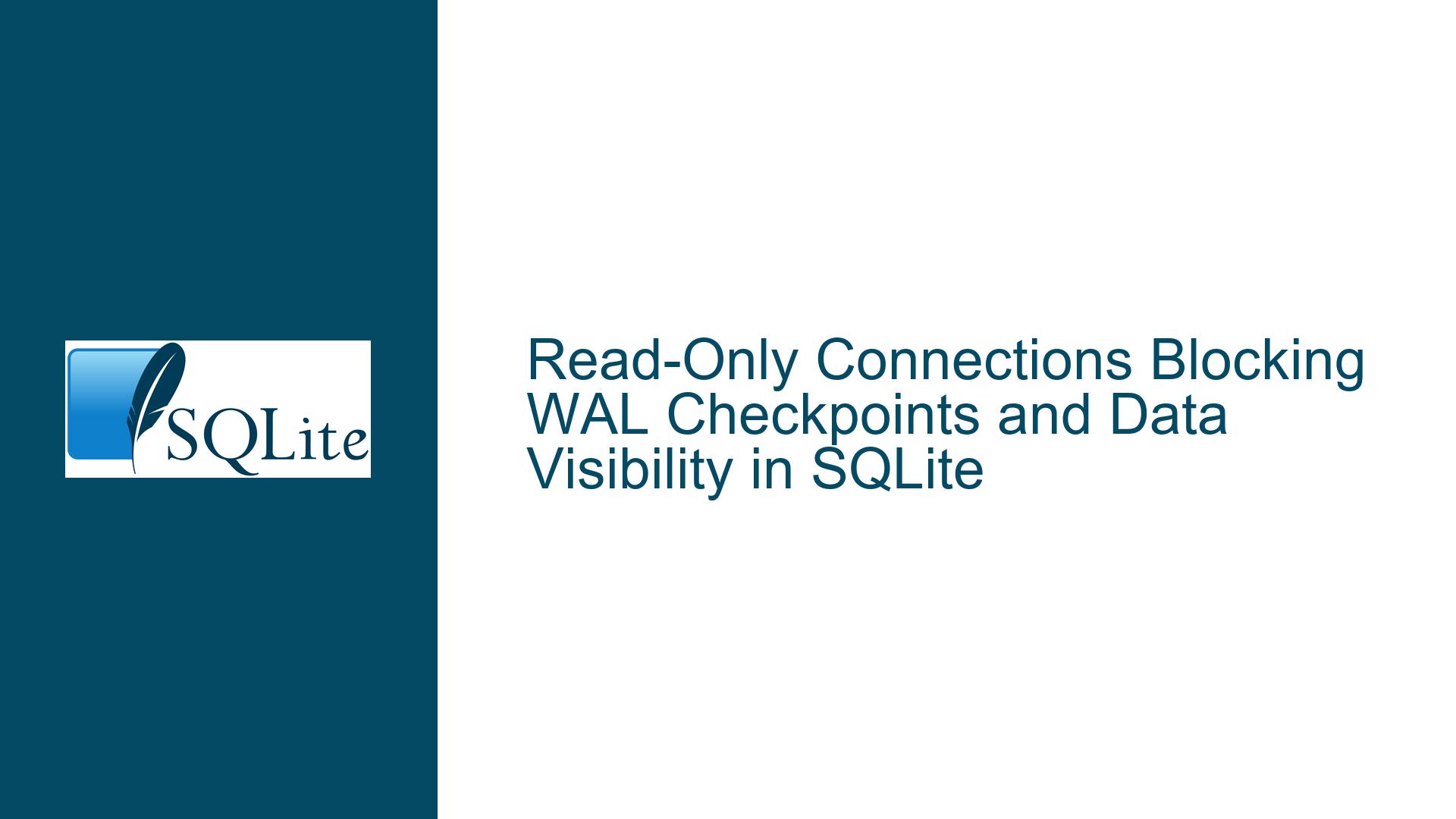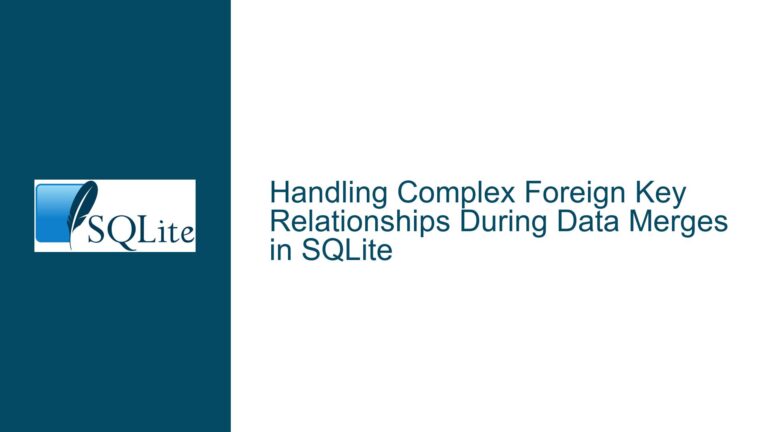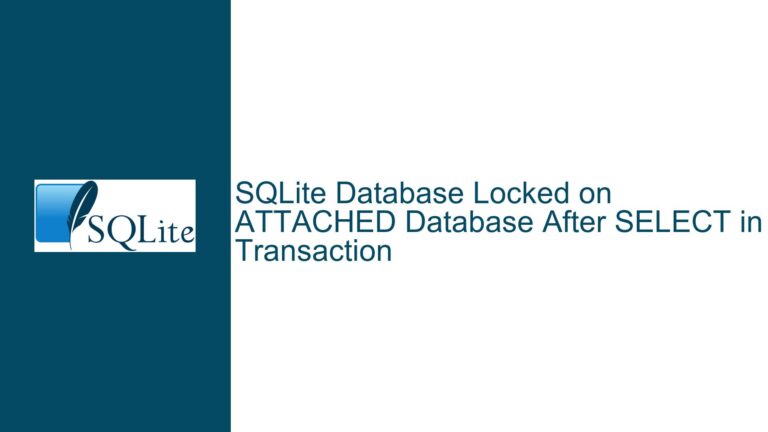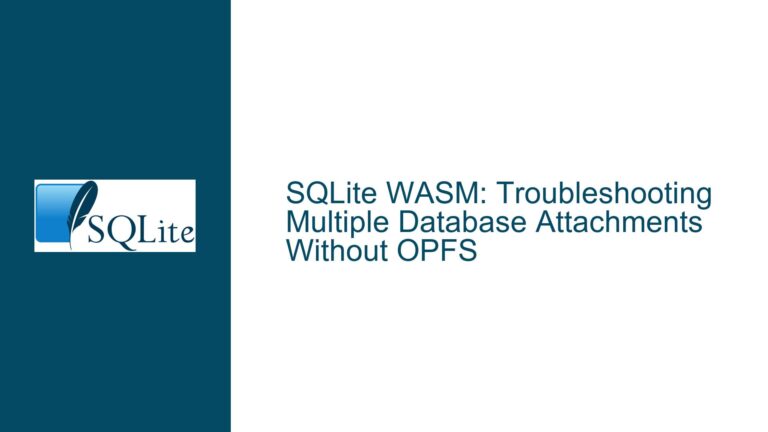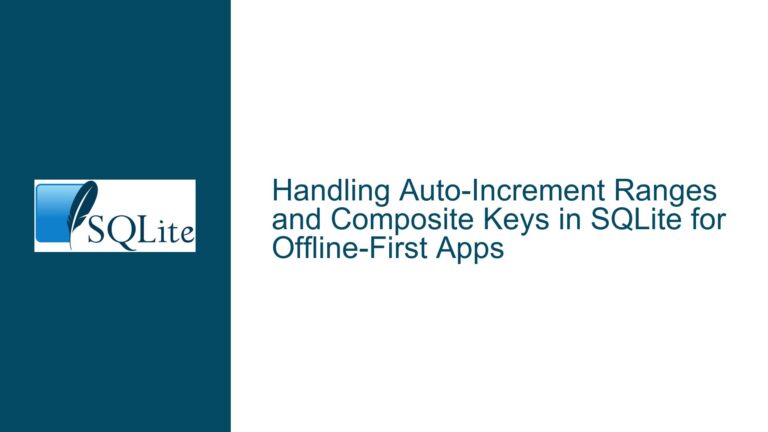Read-Only Connections Blocking WAL Checkpoints and Data Visibility in SQLite
Understanding Transaction Snapshots and WAL Checkpoint Blocking
Issue Overview
When working with SQLite in Write-Ahead Logging (WAL) mode, persistent read-only connections may prevent checkpoint operations from advancing and fail to observe newly inserted data. This occurs because long-lived read transactions maintain a historical snapshot of the database, blocking the WAL checkpointing process from reclaiming unused WAL frames. The writer connection reports checkpoint failures in passive mode (SQLITE_CHECKPOINT_PASSIVE), where sqlite3_wal_checkpoint_v2 returns SQLITE_OK but no frames are checkpointed (as indicated by *pnCkpt = 0). In full checkpoint mode (SQLITE_CHECKPOINT_FULL), the writer enters a busy loop due to the read connection holding a transaction open indefinitely. Data visibility issues arise because the reader operates on a stale snapshot created at the start of its transaction, even if the writer commits new changes. This behavior is intrinsic to SQLite’s transaction isolation model but becomes problematic when application logic assumes read connections automatically see latest writes without explicit transaction boundaries.
Key Mechanisms Behind Snapshot Retention and Checkpoint Blocking
Read Transactions and Snapshot Lifetimes:
Every SQLite read transaction (explicitBEGINor implicit viaSELECT) establishes a snapshot of the database state. In WAL mode, this snapshot corresponds to a specific position in the WAL file. The snapshot remains active until the transaction is committed or rolled back. A persistent read connection that never finalizes its transaction retains this snapshot indefinitely, forcing the WAL to retain all changes made after the snapshot began. Checkpointing cannot proceed beyond the earliest active snapshot, as doing so would invalidate historical data required by ongoing transactions.WAL Checkpoint Modes and Their Interactions:
- Passive Checkpointing: Attempts to checkpoint as much as possible without disrupting other connections. Fails silently if readers hold open transactions, resulting in
*pnCkpt = 0. - Full Checkpointing: Requires exclusive access to the database to finalize the checkpoint. Blocks indefinitely if readers do not release transactions, triggering busy timeouts or handler loops.
- Restart/Truncate Checkpointing: More aggressive modes that may forcibly evict readers but are unsupported in default configurations or incompatible with certain platform file locking semantics.
- Passive Checkpointing: Attempts to checkpoint as much as possible without disrupting other connections. Fails silently if readers hold open transactions, resulting in
Connection and Statement Handle Lifecycle:
Unfinalized prepared statements (sqlite3_stmtobjects) or uncommitted transactions keep associated database connections in an active state. Even if no explicitBEGINis issued, certain API usage patterns (e.g., executingSELECTwithout resetting statements) implicitly extend transaction lifetimes. This is exacerbated when connection pooling or long-lived reader connections are used without rigorous statement cleanup.SQLITE_OPEN_NOMUTEX and Threading Considerations:
UsingSQLITE_OPEN_NOMUTEXallows concurrent access across threads but places responsibility on the application to serialize operations. Mismanaged threading can lead to interleaved transactions that inadvertently extend snapshot retention. For example, a reader thread might initiate a transaction, yield to another thread, and resume much later without having closed the original transaction.
Resolving Snapshot Retention and Checkpoint Blocking
Step 1: Audit Read Connection Transaction Boundaries
Explicit Transaction Finalization:
Ensure everyBEGIN(explicit or implicit) is paired withCOMMITorROLLBACK. For read-only connections, executeCOMMITimmediately after fetching data to release the snapshot. Example remediation:sqlite3_exec(db, "BEGIN; SELECT ...; COMMIT;", ...); // Explicit commit after readAvoid:
sqlite3_exec(db, "BEGIN;", ...); // ... application runs indefinitely without COMMIT ...Autocommit Status Verification:
Usesqlite3_get_autocommit()to detect lingering transactions. A return value of0indicates an open transaction. Integrate this check before reusing a read connection for subsequent queries:if (sqlite3_get_autocommit(db) == 0) { sqlite3_exec(db, "COMMIT;", 0, 0, 0); }
Step 2: Validate Prepared Statement Cleanup
Finalize or Reset All Statements:
After executing a query viasqlite3_step(), either finalize the statement withsqlite3_finalize()or reset it withsqlite3_reset(). Unreset statements keep transactions open, especially those involving cursors or multi-step queries. Implement a cleanup loop:sqlite3_stmt *stmt; while ((stmt = sqlite3_next_stmt(db, 0)) != 0) { sqlite3_reset(stmt); // Or sqlite3_finalize(stmt) if done }Avoid Cursor-Based Pagination Without Timeouts:
Applications fetching large datasets in chunks (e.g.,LIMIT/OFFSET) may hold transactions open across fetch operations. Either useCOMMITbetween chunks (risking inconsistent reads) or employ query patterns that avoid long-running transactions.
Step 3: Adjust Checkpointing Strategy and WAL Configuration
Aggressive Checkpoint Scheduling:
Trigger checkpoints (SQLITE_CHECKPOINT_RESTART) during periods of low activity, or after confirming no read transactions are active. Usesqlite3_wal_checkpoint_v2()with a busy handler that retries transient lock conflicts.WAL Size Management:
SetPRAGMA journal_size_limitto prevent unbounded WAL growth when checkpoints are blocked. This forces SQLite to returnSQLITE_FULLif the WAL exceeds the limit, providing an opportunity to alert operators or terminate blocking readers.Reader Timeout Policies:
Configuresqlite3_busy_timeout()on writer connections to avoid indefinite blocking during full checkpoints. Combine with exponential backoff in busy handlers to balance checkpoint progress with system responsiveness.
Step 4: Connection Pooling and Reuse Policies
Reader Connection Lifespan:
Recycle read connections after a maximum number of transactions or elapsed time. For example, close and reopen connections every 100 transactions or 5 minutes to ensure snapshots are periodically refreshed.Writer-Initiated Checkpoint Coordination:
Have the writer connection signal readers (via application-level mechanisms) to release transactions before initiating a checkpoint. Readers can acknowledge by committing transactions and reopening them post-checkpoint.
Step 5: Diagnostic Queries and Logging
Monitor Active Snapshots:
QueryPRAGMA wal_checkpoint(TRUNCATE);periodically to observe checkpoint progress. ThePRAGMA wal_autocheckpoint;setting controls automatic checkpointing, which may conflict with manual attempts if misconfigured.WAL Status Inspection:
UsePRAGMA wal_status;to retrieve details about current WAL frames, checkpoint locks, and reader connections. Correlate this data with application logs to identify long-running transactions.SQLITE_LOCK_SHARED Tracking:
Detect connections holdingSHAREDlocks (indicative of active read transactions) viasqlite3_db_status(db, SQLITE_DBSTATUS_LOOKASIDE_USED, ...)or external tools likelsofon Unix-like systems.
By systematically addressing transaction boundaries, statement lifecycle management, and checkpoint coordination, developers can mitigate snapshot retention issues while maintaining the concurrency benefits of WAL mode.
